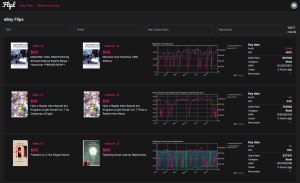In e-commerce, a new era of moneymaking possibilities has emerged for hustlers seeking to rake profits from their home base. Flipping merchandise from eBay to Amazon is one lucrative hustle that’s been making waves lately.
By exploiting the price gaps between these two digital marketplaces, intelligent individuals can pocket a substantial income with minimal initial investment.
Whether you’re an absolute rookie or a seasoned flipper, this article will serve as a treasure trove of wisdom and direction on dominating this profitable business venture.
By the time you finish this article, you’ll be armed with the know-how and self-assurance needed to launch your own flipping expedition, ultimately revolutionizing your financial destiny along the way. So, let’s dive headfirst into the thrilling realm of flipping items from eBay to Amazon!
Understanding the Basics of Flipping
Flipping is a form of online arbitrage that refers to purchasing items at a low price from one marketplace and then selling them at a higher price on another marketplace, with the difference in price being the profit.
In the context of this article, flipping involves buying products on eBay for cheap and selling them on Amazon for a profit.
How Flipping Works
The flipping process generally involves the following steps:
1. Research and source profitable items on eBay.
2. Purchase the items at a lower price than what they can be sold for on Amazon.
3. List and sell the items on Amazon, making sure to account for any fees and expenses.
4. Ship the items to the buyer and handle any customer service issues that may arise.
The key to successful flipping is finding products with high demand and underpriced on eBay, allowing you to sell them at a higher price on Amazon.
The Benefits of Flipping Items from eBay to Amazon
There are several benefits to flipping items from eBay to Amazon, including:
1. Profit potential: If done correctly, flipping can generate significant profits by taking advantage of the price differences between the two marketplaces.
2. Low startup costs: As you only need an internet connection and capital to purchase the inventory, there are relatively low barriers to entry when starting a flipping business.
3. Flexibility: Flipping can be done part-time or full-time, depending on your availability and income goals.
4. Expanding your product knowledge: You’ll naturally learn about different industries and market trends as you research and source various products.
5. Building valuable skills: Flipping teaches you important business skills such as research, negotiation, and customer service.
Sourcing Profitable Items on eBay
Researching popular and in-demand products
To be successful in flipping items from eBay to Amazon, the first step is finding popular and in-demand products on eBay. To do this, you can use eBay’s search filters to narrow down your search to specific categories, price ranges, and item conditions. Additionally, you can sort your search results by “Best Match,” “Ending Soonest,” or “Newly Listed” to find the most relevant listings.
Another way to research popular products is by analyzing completed listings and sold items on eBay. To access this information, click on the “Advanced” search option next to the search bar, then check the “Completed listings” or “Sold items” boxes under “Search including.” This will show you what items have recently sold and for how much, giving you valuable insights into which products are in high demand.
Tips for finding under-priced products
Finding underpriced products on eBay is key to maximizing your profits when flipping them on Amazon. To increase your chances of finding such items, consider the following tips:
- Timing your searches: Some sellers may list their items at a low starting price with no reserve, hoping that a bidding war will drive up the final sale price. By searching for items ending soon, you may be able to snag a great deal before other buyers can bid.
- Identifying motivated sellers: Look for listings with typos, poor-quality photos, or vague descriptions, as these sellers may not be as experienced or motivated to get top dollar for their items. You can capitalize on these less-than-perfect listings by offering a quick sale at a discounted price.
Assessing the potential profit margin of items
Before purchasing an item on eBay to flip on Amazon, it’s crucial to assess the potential profit margin to ensure that it’s worth your time and effort.
To do this, consider the following steps:
- Calculating fees and expenses: Both eBay and Amazon charge various fees for using their platforms, such as listing fees, final value fees, and referral fees. Additionally, you’ll need to account for shipping costs and any other expenses related to packaging and handling. Make sure to factor these costs into your calculations to determine if an item will provide a sufficient profit margin.
- Comparing prices on Amazon: Once you’ve calculated your potential expenses, search for the same or similar items on Amazon to see how much they’re selling for. This will give you an idea of the potential profit you can make by flipping the item. Remember that Amazon prices can fluctuate, so it’s essential to monitor them regularly and adjust your pricing strategy accordingly.
Listing and Selling Items on Amazon
Creating an Amazon Seller Account
The first step is to create an Amazon Seller account to start listing and selling items on Amazon. There are two types of accounts: Individual and Professional. An Individual account has no monthly subscription fee but charges a per-item fee for each sale, while a Professional account has a monthly subscription fee but offers additional benefits such as bulk listing tools and eligibility to win the Buy Box. Choose the account type that best suits your business needs and budget.
Listing Items for Sale
Once you have an Amazon Seller account, you can start listing items for sale. Here are some tips to make your listings stand out from the competition:
Writing Compelling Product Descriptions
An engaging and informative product description is essential for attracting potential buyers. Highlight the product’s key features and benefits while addressing any common questions or concerns that customers may have. Use bullet points to make the description easy to read and understand, and include relevant keywords to help your listing rank higher in search results.
Taking High-Quality Product Photos
High-quality product photos can significantly impact a buyer’s decision to purchase. Use a clean, well-lit background to showcase the item from multiple angles. Ensure the images accurately represent the item’s condition and highlight any unique features or details. Invest in a professional camera or hire a photographer to capture professional-looking images.
Pricing Strategies for Maximizing Profit
Pricing your items competitively is crucial for maximizing your profits. Research similar items on Amazon to get an idea of the market price, and consider factors such as item condition, brand, and shipping costs when setting your price.
You can also use repricing tools to automatically adjust your prices based on competitor pricing and sales history, ensuring that your listings remain competitive without constant manual adjustments.
Managing Inventory and Order Fulfillment
Efficient inventory management and order fulfillment are essential for maintaining customer satisfaction and minimizing potential issues:
Shipping Options
Amazon offers various shipping options to sellers, including Fulfillment by Amazon (FBA), where Amazon handles storage, shipping, and customer service on your behalf. Alternatively, you can choose to handle shipping yourself using the Merchant Fulfilled Network (MFN).
Consider factors such as cost, convenience, and delivery speed when selecting the best shipping method for your business.
Handling Returns and Customer Service
Providing excellent customer service is crucial for maintaining a positive reputation on Amazon. Respond to customer inquiries promptly and professionally, and address any issues or concerns that may arise.
Familiarize yourself with Amazon’s return policies and ensure you comply. Be prepared to handle returns and issue refunds when necessary, as this can help maintain customer satisfaction and minimize negative feedback.
Building a Sustainable Flipping Business
Scaling up your operations
To build a sustainable flipping business, it’s essential to scale up your operations as you become more experienced and gain profit. One way to do this is by automating tasks with software like Flipl.io. This platform helps you analyze and track products, enabling you to make better decisions about which items to flip. By automating these processes, you can save time and increase the efficiency of your business.
Another method to scale up your operations is by outsourcing tasks to freelancers or virtual assistants. This can help you focus on the core aspects of your business while delegating time-consuming tasks like product research, listing creation, and customer service. Outsourcing can also help you maintain a healthy work-life balance, preventing burnout and ensuring long-term success.
Staying informed about market trends and industry news
To stay competitive in the flipping business, staying informed about market trends and industry news is crucial. This can help you identify new opportunities and adjust your strategies accordingly. Follow blogs, forums, and social media accounts related to eCommerce, eBay, and Amazon selling to stay informed about the latest developments, tips, and tricks in the industry.
Diversifying your product portfolio for long-term success
Relying on a single product category or niche can be risky in the long run. To ensure long-term success, consider diversifying your product portfolio by exploring different niches and categories. Expanding your product offerings can help you tap into new markets, increase your customer base, and minimize the impact of seasonal fluctuations or changes in consumer preferences.
Diversifying your product portfolio also reduces the risk of being too dependent on a single supplier or product. This can help you maintain a steady income stream even if one product category underperforms or faces increased competition.
By scaling up your operations, staying informed about market trends, and diversifying your product portfolio, you’ll be well on your way to building a sustainable flipping business. With dedication and persistence, flipping items from eBay to Amazon can become a profitable and fulfilling venture.
Common Challenges and How to Overcome Them
Dealing with competition from other sellers
Competition is inevitable in any business, and flipping items from eBay to Amazon is no exception. To stay ahead of your competitors, you need to constantly research and monitor the market for profitable products. Keep an eye on the items that are in high demand and have lower competition.
Additionally, focus on providing excellent customer service and maintaining a good seller reputation. This will help you stand out from the competition and attract more buyers to your listings.
Navigating eBay and Amazon’s policies and fees
Both eBay and Amazon have specific policies and fees that sellers must adhere to. It’s crucial that you familiarize yourself with these rules to avoid account suspensions or penalties. Be sure to follow guidelines for listing items, shipping, and handling returns.
As for fees, take the time to understand the different charges associated with selling on each platform, including listing fees, final value fees, and subscription fees. Incorporate these costs into your pricing strategy to ensure you maintain a healthy profit margin.
Managing cash flow and maintaining a steady income
One of the biggest challenges in flipping items from eBay to Amazon is managing your cash flow. Since you’ll be investing money in purchasing items from eBay and waiting for them to sell on Amazon, it’s crucial to have a solid financial plan in place.
Keep track of your expenses, including purchasing costs, shipping fees, and platform fees. Monitor your sales and profits regularly to ensure that your flipping business is generating a steady income.
If you find that your cash flow is tight, consider adjusting your pricing strategy or sourcing less expensive items to flip. Also, consider reinvesting a portion of your profits back into the business to help it grow and sustain itself.
Conclusion
Recap of the key points discussed in the article
In this article, we have provided a comprehensive guide on flipping items from eBay to Amazon for big profits. We began by discussing the basics of flipping, including its definition, process, and benefits. We then delved into sourcing profitable items on eBay by researching popular and in-demand products, identifying under-priced items, and assessing potential profit margins.
Next, we explored the process of listing and selling items on Amazon, covering details such as creating a seller account, writing compelling product descriptions, taking high-quality photos, and employing smart pricing strategies. Additionally, we discussed inventory management, order fulfillment, shipping options, and handling customer service.
To build a sustainable flipping business, we emphasized the importance of scaling up operations through automation and outsourcing, staying informed about market trends, and diversifying your product portfolio. Finally, we addressed common challenges faced by flippers, such as competition from other sellers, navigating platform policies and fees, and managing cash flow.
Encouragement for readers to start their flipping journey
Now that you have a solid understanding of the flipping process and its potential for profit, we encourage you to take the first steps in your flipping journey. With dedication, persistence, and a willingness to learn from mistakes, you can successfully build a profitable business flipping items from eBay to Amazon.
Final tips for success in flipping items from eBay to Amazon
As you embark on your flipping journey, remember these final tips for success:
1. Always conduct thorough research to ensure you are investing in profitable items with strong demand.
2. Keep an eye on market trends and adjust your product offerings accordingly.
3. Continuously refine your listing quality and pricing strategies to stay competitive.
4. Focus on providing excellent customer service to build a strong reputation on Amazon.
5. Be patient and persistent, as building a successful flipping business takes time and effort.
By following these tips and the guidance provided throughout this article, you will be well on your way to achieving success in flipping items from eBay to Amazon. Happy flipping!







